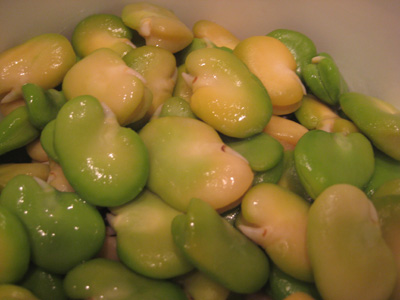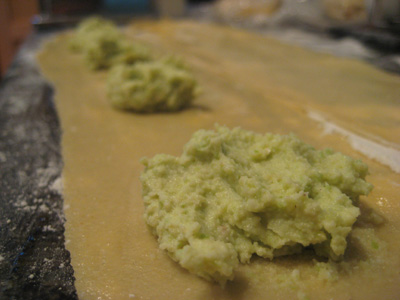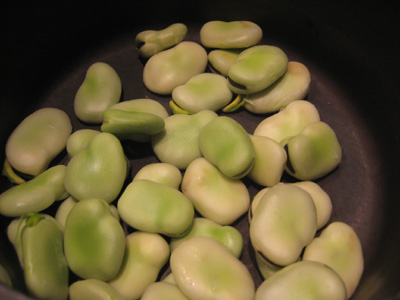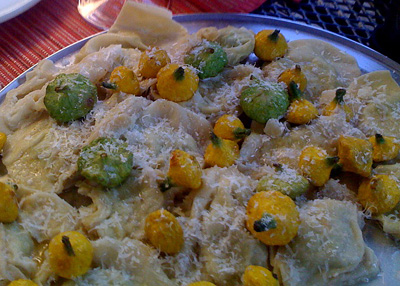So Why Use Fava's in Ravioli?
My love for fava beans made them a natural choice for a ravioli filling recently, although I didn't realize this when I was planning the menu. I was hosting a pasta party for some friends, which included two people who do not eat meat. I knew I wanted to make ravioli, but because my stock ravioli filling of late has been a short rib ragu, I had to think outside the box. So as I walked the aisles at Berkeley Bowl, I surveyed the piles of fresh vegetables around me seeking ravioli-filling inspiration. And then it hit me, right in the bean aisle. Raviolis made with my favorite seasonal bean pureed with cream and cheese. What could be nicer for a June pasta dinner eaten on the patio with friends?

The raviolis were a hit. The beans pureed texture held up nicely in the ravioli and the addition of cream, ricotta and Parmesan aligned nicely with the fresh pasta dough. Even the meat eaters -- two of whom were avowed fava-bean haters -- said they loved the dish. I decided to believe them as one is a good friend who has a tendency to be brutally honest in a very kind way, so I know she would tell me if she hated my ravioli; and the other is a lovely man who is far too polite to announce his displeasure with a meal, but is sincere enough to just leave whatever he doesn't like on his dish -- and he had seconds.
So if you're looking to delight your friends and family with a seasonal alternative to meat ravioli filling -- one that also includes an interesting history plus may additionally rev up your love life -- look no further than favas. Just please don't eat them with liver.
Note: If you're not up for making raviolis, you can also use this filling as a creamy sauce for regular pasta.

Pureed Fava Bean Ravioli
Makes: Enough for 4-6 people
Ingredients:
2 cups shelled fava beans (just fill up a produce plastic bag with them and you'll have enough)
1/4 cup chopped shallots
1 Tbsp olive oil
1/2 cup unsalted butter
1/2 cup heavy cream
1/2 cup ricotta cheese
1/4 - 1/3 cup Parmesan cheese (according to taste)
2 Tbsp whole milk
1 Tbsp chopped basil or mint (optional)
1 batch of homemade pasta dough
Preparation:
1. Prepare pasta dough and refrigerate until ready for use.
2. Shell fava beans from pods. Bring a medium pot of water to a boil and then drop the beans in. Simmer for 2 minutes and then remove the beans from the pot and rinse with cold water.
3. Gently remove the outer bean casing from the tender inner bean. I usually just separate one side a bit and then gently squeeze the bean into a bowl. Do this for all the beans.
4. In a medium pan, sauté the chopped shallots in the olive oil for about 2 minutes on medium heat. Add in the fava beans and 2 Tbsp butter and cook until the beans are cooked through. Add in salt to taste.
5. Let beans and shallots cool and then pour them in a chopper along with your heavy cream, milk, ricotta, and some freshly ground black pepper. Puree until smooth.
6. If the puree seems too chunky or thick, add more heavy cream or milk as needed. Add in the Parmesan Cheese and any herbs you're using and then puree further until the mixture is completely smooth has the consistency of thick batter. Taste and add more salt and pepper as needed.
7. Roll out your pasta dough so you have long strips 4 inches wide. Spoon about 1 Tbsp puree 1 1/2 inches apart.
8. Brush egg wash on each side and in the strips between the puree and then place a 2nd pasta dough strip on top. Press down on each side in between raviolis so the pasta dough adheres along all sides of the filling and then cut out your raviolis. I like to use a pizza cutter to do this, but if you have a fancy ravioli cutter, go for it.
9. Boil pasta in salted water for about 3 minutes (or until raviolis are cooked) and then gently remove them from the pot and set in a serving dish.



